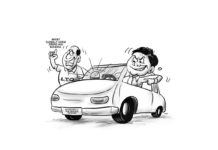
THE LOW pressure area inside the Philippine area of responsibility became a tropical depression yesterday and is now called “Chedeng”. It is expected to become a typhoon in the coming days and become stronger by the weekend, according to the Philippine Atmospheric Geophysical and Astronomical Services Administration.
Concerned public and disaster risk reduction and management offices are advised to take all necessary measures to protect life and property.
Residents of areas prone to hazards are advised to follow evacuation and other instructions from local officials.
During recent storms, the up-to-date advisories of our much improved state weather bureau were a big help. Local government units knew what to do during bad weather conditions.
Adequately preparing for storms means knowing them fully well and the dangers they bring. Having experts gather and validate scientific data allows the accurate prediction of events, which could then be matched with the best practical solutions. When and where a typhoon will strike, and how, are critical knowledge that will allow the community to timely seek safer ground and fully protect their homes and properties.
For example, during the onslaught of super typhoon “Yolanda” in November 2013, all 500 houses in the island of Tulang Diyot (Municipality of San Francisco, Cebu province) were destroyed but the entire population was saved because of prompt evacuation. When it was clear from weather forecasters how bad the typhoon would be, the local government decided to evacuate all 1,000 people. Because they’ve done so much work on disaster risk, everyone fully understood the need to move to safety.
Lesson – scientific data, sound disaster management policies and the political will to implement them won’t complete the formula for effective disaster prevention if there is no public cooperation. Early and mandatory evacuation would be useless if the people do not understand the need for such efforts.
Let us also make every Filipino disaster-literate and let the science work for us. Raising public awareness should be made to resonate loudly and as far deep into the communities as possible.




